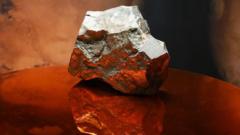Sotheby's describes this specimen as "unbelievably rare," with only around 400 pieces of Martian meteorites ever located on Earth. Cassandra Hatton, vice-chairman of science and natural history at Sotheby’s, highlighted the incredible rarity of this piece, stating, "The odds of this getting from there to here are astronomically small." She further noted the lucky occurrence of the meteorite landing on dry land as opposed to oceanic surfaces, emphasizing the numerous challenges of retrieving such specimens.
The final price for the meteorite climbed to approximately $5.3 million due to additional taxes and fees associated with the sale. The auction, which showcased over 100 items, also featured other fossilized treasures, such as a Ceratosaurus skeleton that was sold for $26 million and a Pachycephalosaurus skull for $1.4 million. The destination of the Mars meteorite post-sale remains undisclosed, as the details of the transaction are kept private.
With its astronomical price tag and unparalleled characteristics, NWA 16788 not only represents a significant piece of space exploration history but also reminds us of humanity’s fascination with the cosmos.
The final price for the meteorite climbed to approximately $5.3 million due to additional taxes and fees associated with the sale. The auction, which showcased over 100 items, also featured other fossilized treasures, such as a Ceratosaurus skeleton that was sold for $26 million and a Pachycephalosaurus skull for $1.4 million. The destination of the Mars meteorite post-sale remains undisclosed, as the details of the transaction are kept private.
With its astronomical price tag and unparalleled characteristics, NWA 16788 not only represents a significant piece of space exploration history but also reminds us of humanity’s fascination with the cosmos.






















